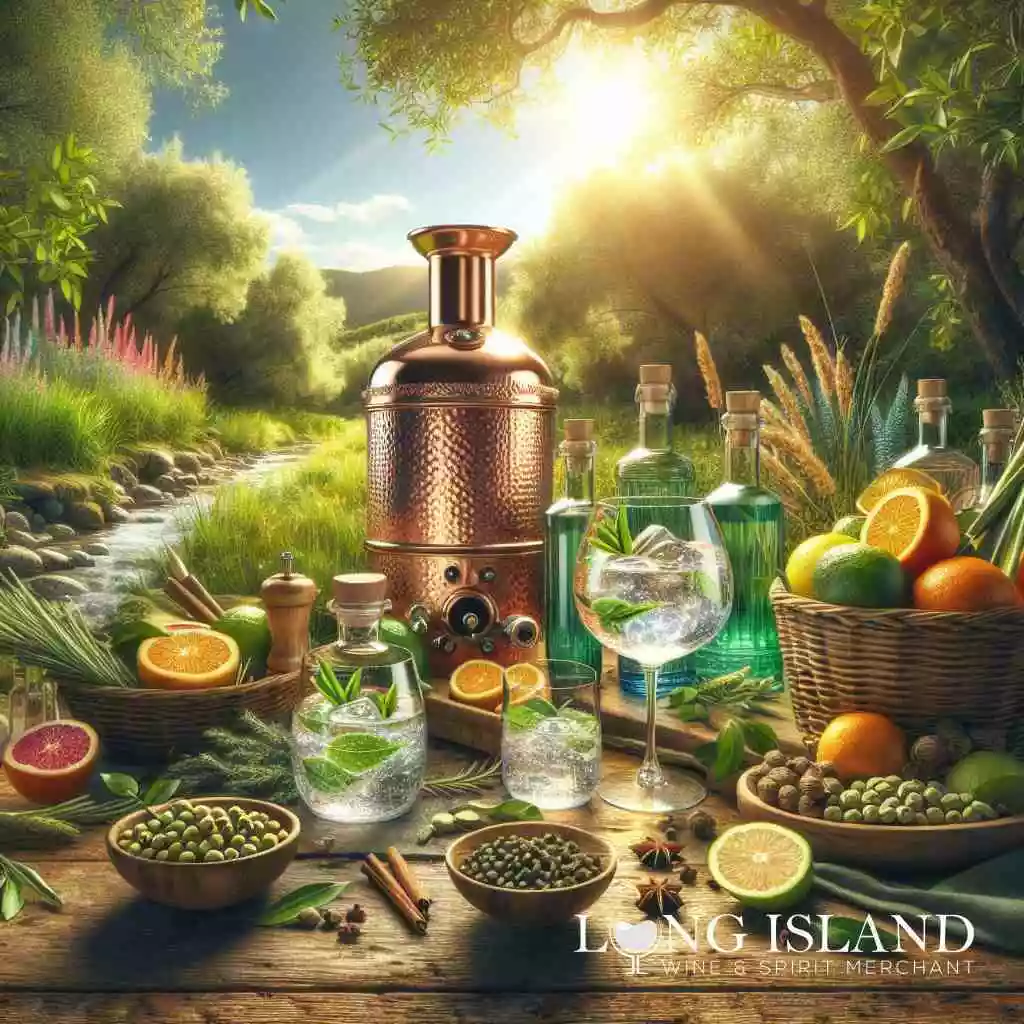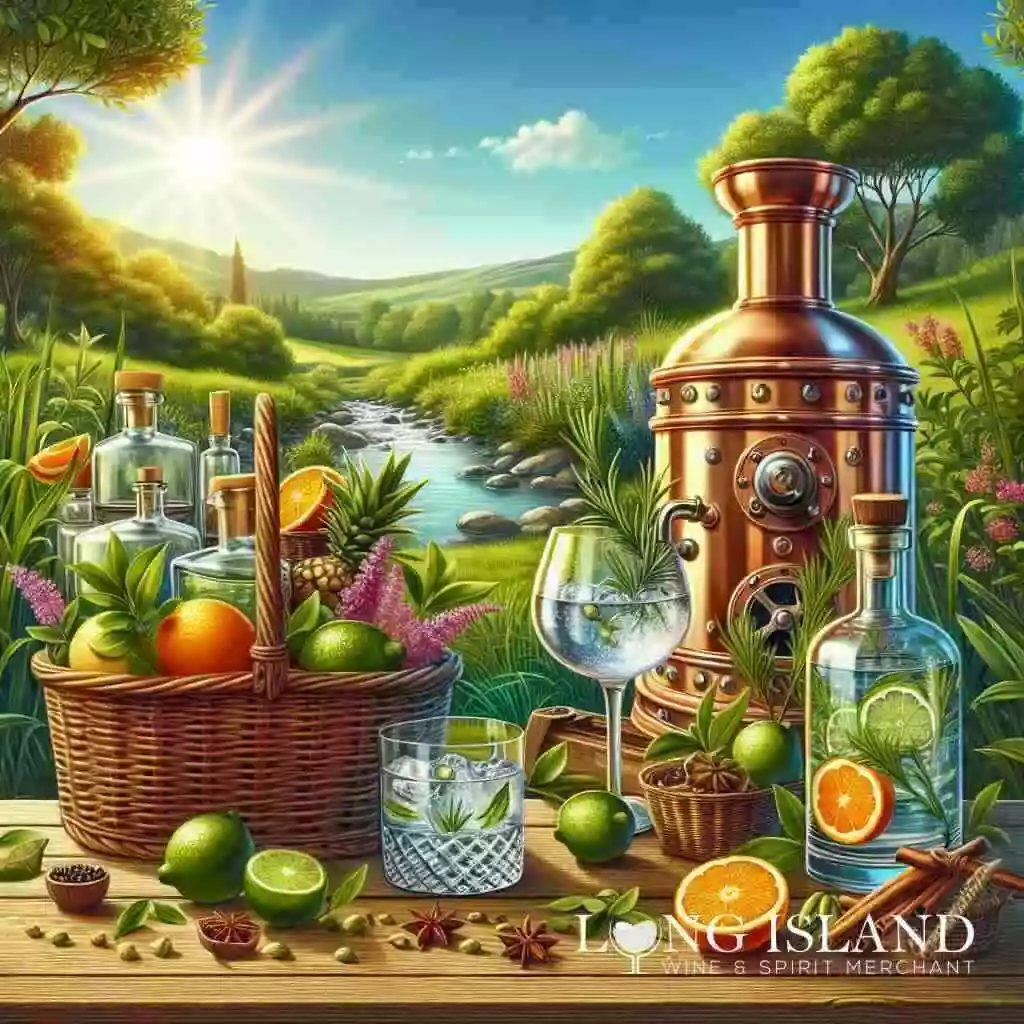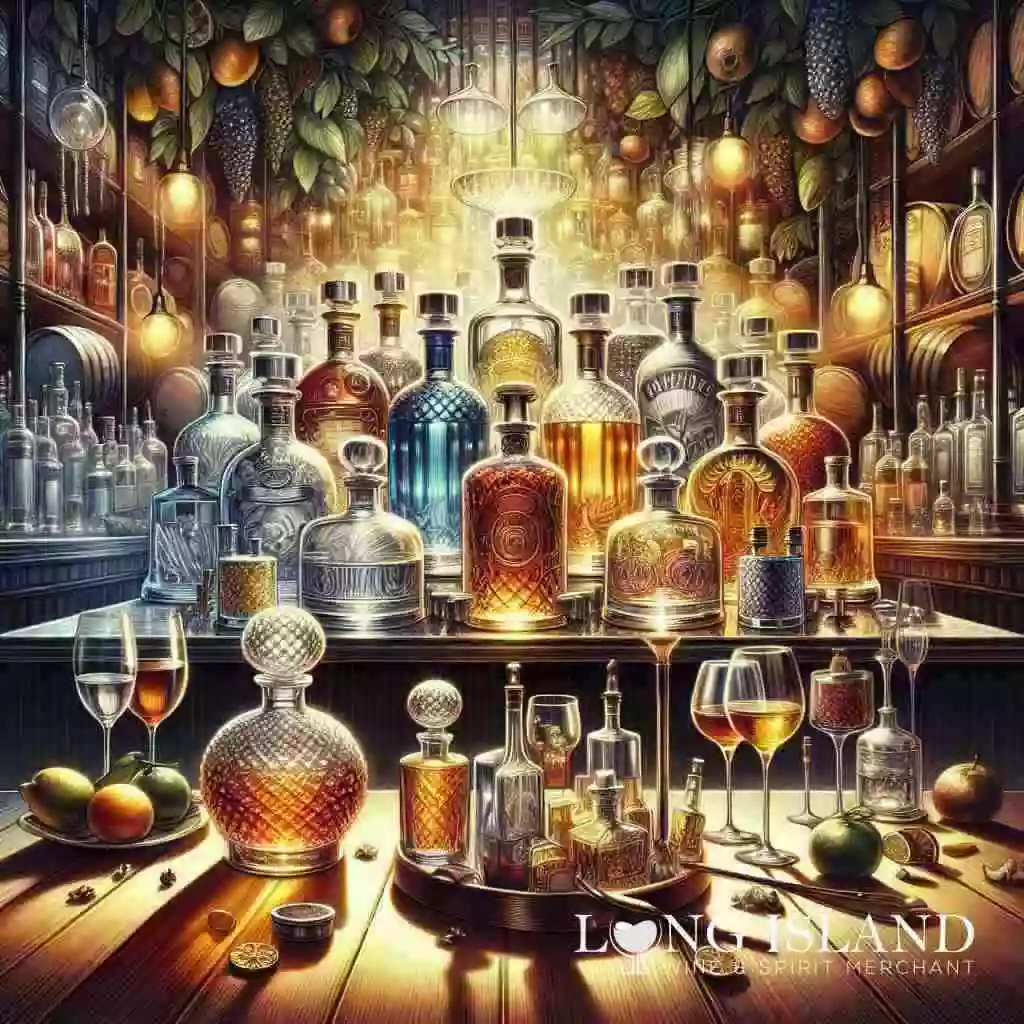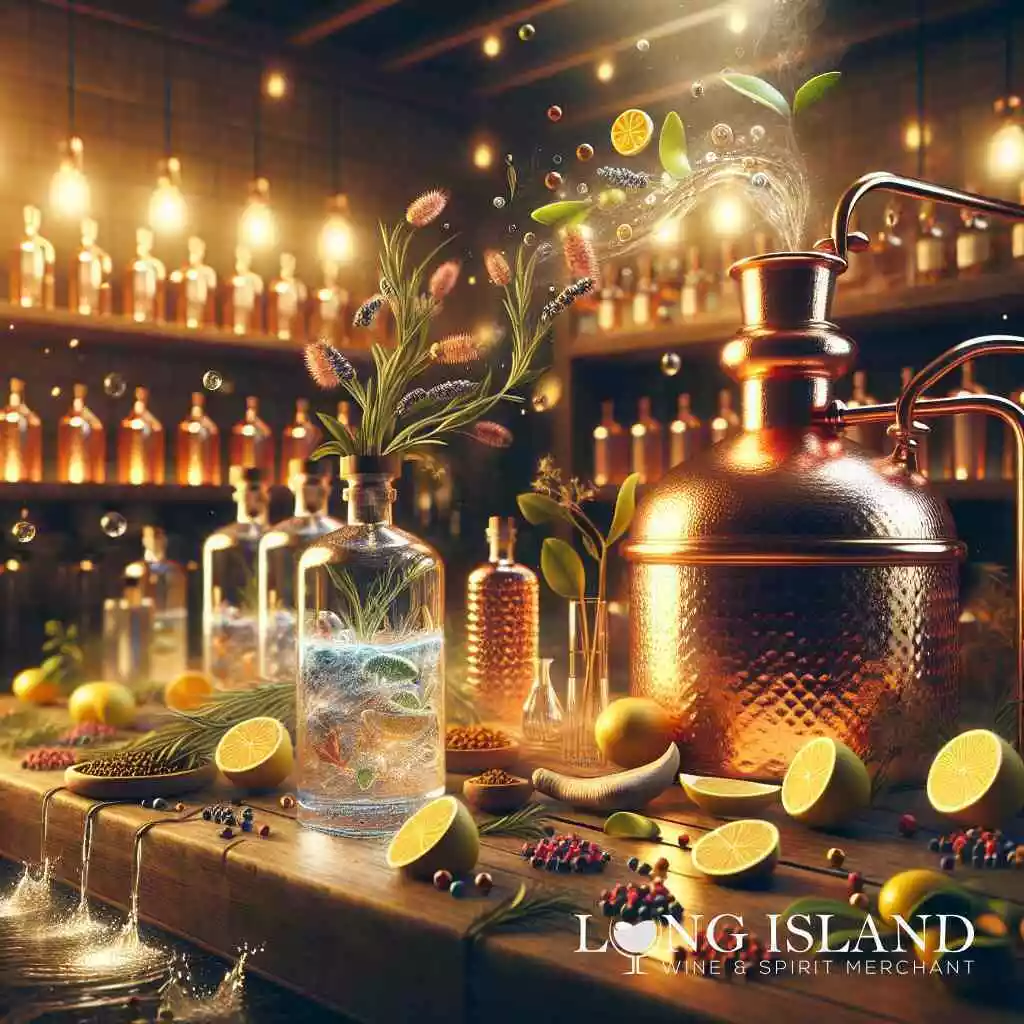
What are Gin Botanicals? A 2024 Exploration
July 26, 2024
Gin Botanicals Unveiled
Introduction to Gin and Its Essence
Gin, a spirit synonymous with complexity and refinement, owes its distinctive taste to the harmonious blend of botanicals, with juniper berries at its heart. This cherished liquor, celebrated for its versatility in cocktails, is much more than just an alcoholic beverage; it’s an artisanal creation that captures the essence of nature in each sip. The journey of gin begins with its base spirit, typically made from grains, which then undergoes a magical transformation through the infusion of various botanicals, each carefully chosen to impart unique flavors and aromas. This process not only enriches the gin with its characteristic pine-like quality from juniper but also layers it with a multitude of aromatic nuances, making every gin a unique expression of its creators’ vision and the botanicals’ origins.
The History and Evolution of Gin Botanicals
The history of gin is a fascinating tale that spans centuries, with its roots tracing back to the early medicinal practices of Europe. Concocted initially by monks and alchemists as an herbal remedy, gin has evolved tremendously over the years. From its early inception asGeneverr in the 16th century, the Netherlands became the spirit of choice in British colonial times and the backbone of classic cocktails. Gin’s journey is marked by adaptation and innovation. The evolution of gin botanicals has been influenced by trade, exploration, and the quest for new flavors. This historical progression has seen gin’s flavor profile expand from a simple juniper-forward spirit to a complex and sophisticated distillate that embraces a wide array of botanicals, each contributing to the depth and breadth of gin’s taste spectrum.
Why Juniper Berries Reign Supreme
At the heart of each gin lies juniper berries, the only botanical that is legally required to be present in the spirit. These small dark berries are the cornerstone of gin, imparting the classic, piney flavor that is quintessentially gin. Juniper not only defines gin’s character but also plays a pivotal role in harmonizing the other botanicals that are introduced into the distillation process. It acts as a canvas, allowing the delicate balance of spicy, citrus, floral, and exotic elements to shine through while maintaining the signature profile that gin enthusiasts have come to adore. The juniper berry’s supremacy in gin crafting underlines the spirit’s historical significance and its enduring appeal as a versatile, refreshing drink that captivates with every botanical nuance.
Discover more about the art of crafting these botanical-rich spirits in our Liquor Store Blog about gin botanicals, where we delve deeper into the intricacies of gin production and the myriad of flavors that define this illustrious liquor.
The Stunning Variety of Gin Botanicals
Beyond Juniper: The Core Components
While juniper is gin’s soul, a constellation of other botanicals contributes to its multifaceted flavor profile. Coriander seeds are nearly as ubiquitous as juniper, adding layers of spicy, sometimes peppery notes to the spirit. The diversity of gin botanicals can vary wildly from one recipe to another, incorporating everything from roots like orris and angelica, which impart earthy, floral qualities, to fruits and seeds that introduce sweet, tart, or spicy nuances. This wide array of botanicals is what allows gin to be so diverse and adaptable, offering a spectrum of flavors that can appeal to every palate. Among these core components, each distiller finds their magic formula, crafting a gin that’s as unique as a fingerprint, ensuring that there’s always something new to be discovered within the world of gin.
Citrus Botanicals: Brightening the Gin Experience
Citrus elements like lemon, lime, orange, and grapefruit peels are pivotal in adding a refreshing zestiness that lifts the gin’s profile, making it crisp and inviting. These citrus botanicals, whether dried or fresh, contribute a bright top note that perfectly counterbalances the deeper, earthy tones of juniper and other botanicals. This infusion of citrus creates a lively spirit that dances on the palate, ideal for sipping neat or as the star in a variety of cocktails. Accessing the perfect citrus botanicals for gin in cocktails can transform a simple drink into an extraordinary experience, bringing a burst of sunshine into each glass.
Spice Botanicals in Gin: Heat and Complexity
Spice botanicals bring warmth, depth, and complexity to gin, with ingredients like cardamom, cinnamon, nutmeg, and ginger offering a cozy heat that can range from subtle whispers to bold statements. These spices can transform the spirit, adding an exotic twist and layers of flavor that evolve as you sip. The artful inclusion of spice botanicals can lead to gins that are perfect for wintery mixes or that add an intriguing complexity to summer refreshments. It’s this versatility and richness that make spice-infused gins a favorite among those who appreciate a spirit with a robust character and an enduring finish.
Floral Gin Botanicals: A Delicate Touch
Floral notes in gin, contributed by botanicals such as lavender, rose, chamomile, and elderflower, impart a delicate, sweet aroma that can elevate the spirit to new heights of elegance. These botanicals offer a whisper of garden-fresh elegance to the gin, intertwining with the more dominant flavors to create a beautifully balanced bouquet. Floral gins are often sought after for their ability to introduce a soft, aromatic complexity to cocktails, making them a preferred choice for sophisticated drinks that require a light but impactful touch.
Exotic Gin Botanicals: Exploring New Dimensions
As the quest for uniqueness in the gin market continues, distillers are turning to more exotic botanicals to distinguish their spirits. Ingredients like Sichuan pepper, saffron, and hibiscus are being utilized to craft gins with unprecedented flavor profiles. These exotic gin botanicals bring a world of flavors to the table, offering adventurous drinkers new sensory experiences. From the subtly sweet to the pleasantly pungent, these exotic additions push the boundaries of traditional gin, inviting connoisseurs and casual enthusiasts alike to explore the full potential of this versatile spirit.
Crafting the Perfect Gin
The Gin Distillation Process Explained
Gin distillation is both an art and a science, a ballet of precision where flavor complexities are skillfully coaxed from simple ingredients. At its core, the process begins with a neutral base alcohol, which is then redistilled with a blend of botanicals, juniper being the most essential. The distillation process can vary, but most commonly involves steeping the botanicals in the base spirit before undergoing a careful distillation in copper stills. This method allows for the delicate extraction of flavors, resulting in a spirit that is as complex as it is captivating. The distiller’s mastery lies in their ability to balance the infusion of these botanicals, creating a harmonious gin, with each note playing its part yet allowing juniper’s invigorating pine-like quality to shine. The art and science behind the gin distillation process offer a fascinating glimpse into the meticulous craft that defines the very essence of premium gin.
Botanical Recipes for Gin: A Craft Distiller’s Inspiration
The gin maker’s palette is broad, drawing on a diverse garden of botanicals beyond juniper to include celebrated ingredients like coriander, citrus peels, and angelica root, alongside more innovative selections such as cucumber or rose petals. Each craft distiller seeks inspiration from their local landscape, cultural heritage, or culinary trends, crafting recipes that reflect a specific vision or narrative. These botanical recipes are more than formulas; they are expressive works of art that transport the drinker through taste, aroma, and texture. Achieving the perfect symphony of flavors necessitates a deep understanding of each botanical’s characteristics and how they interact within the spirit. Distillers thus become akin to composers, with botanicals as their notes, blending tradition and innovation to craft gins of distinction and character. For those inclined towards adopting the mantle of the distiller, seeking craft distillers’ inspiration for gin botanical recipes can be a thrilling first step on a creative journey through gin crafting.
Homemade Gin Botanicals: DIY Infusions
The burgeoning interest in craft spirits has inspired a wave of DIY enthusiasts to experiment with homemade gin, making the realm of botanicals more accessible than ever. Crafting gin at home allows individuals to tailor their recipes to personal preferences, exploring a world of flavor combinations from the comfort of their kitchens. The process begins with a high-quality base spirit into which a variety of botanicals are infused, either through steeping or vapor infusion methods. This hands-on approach enables gin creators to experiment with both traditional and more unconventional botanicals, discovering unique profiles that challenge and expand the palate. From selecting suitable juniper berries to incorporating exotic spices or floral hints, DIY gin crafting is a deeply personal and rewarding endeavor. For fans eager to embark on this journey, resources and guides on homemade gin botanicals for DIY infusions offer invaluable insights into techniques, recipes, and the endless possibilities that homemade gin botanicals present.
From Classic to Contemporary: Types of Gin
Understanding the Different Styles of Gin
Gin has traversed a long and fascinating path, emerging from its origins as a medieval herbal remedy to become one of the most beloved spirits in the contemporary world. This transformation has given rise to a diverse spectrum of gin types, each distinguished by its unique profile of botanicals, distillation processes, and geographic origins. Traditional styles such as London Dry Gin, known for its crisp, juniper-forward character, and Old Tom Gin, sweeter and softer in comparison, provide a historical backdrop against which newer styles contrast. Meanwhile, the resurgence ofGeneverr, gin’s malty forebear, highlights the spirit’s rich heritage and versatility. Craft distillers have played a pivotal role in expanding the gin landscape further, introducing innovative styles like New American Gin, which often features more experimental and pronounced botanicals, diverging from the juniper dominance. This exploration into varying styles underscores gin’s adaptability and its ability to evolve while retaining its core identity.
The Rise of Craft Gin: A New Era of Flavor
The craft gin movement marks a significant shift in the spirit’s evolution, driven by a desire to push beyond traditional boundaries and explore a broader palette of flavors and botanicals. Craft distilleries, leveraging local ingredients and artisanal production techniques, have ushered gin into a new era of flavor characterized by distinct regional profiles, innovative botanical infusions, and a keen emphasis on quality. This renaissance of gin craftsmanship has not only revitalized the classics but also introduced a vibrant array of new expressions, enticing both connoisseurs and new drinkers with its diversity and depth. From craft spirits related to gin in New York, the movement showcases the limitless possibilities of gin, rooted in tradition yet boldly facing the future. It’s this blend of reverence for history and the excitement of innovation that defines craft gin’s appeal and its continuing rise in popularity.
Spotlight on Botanical Gin Brands
In the expanding universe of gin, botanical gin brands stand out for their dedication to capturing the essence of nature in their bottles. These brands, often at the forefront of the craft gin scene, distinguish themselves through their meticulous selection of botanicals, ranging from the familiar to the exotic, each chosen for its ability to contribute to the gin’s unique flavor profile. Highlighting local flora and rare ingredients, these distilleries offer gins that are as much a reflection of their environment as they are of their creators’ ingenuity. Brands like Botanical gin brands showcasing in Long Island epitomize this trend, combining traditional gin botanicals with locally sourced herbs and spices to create spirits that are rich, complex, and symbolic of their origins. This emphasis on botanical diversity not only enriches the gin-drinking experience but also encourages a deeper appreciation of the natural world and the myriad flavors it has to offer.
The Art of Tasting Gin
Decoding Gin Tasting Notes: A Sensory Journey
Gin, with its rich tapestry of botanicals, offers a sensory journey that is as diverse as it is compelling. As we explore gin’s aromatic landscape, juniper, of course, takes center stage, enveloping the senses with its refreshing pine-like quality. Beyond juniper, we uncover layers of complexity-citrus notes that sparkle with vivacity, spicy undertones that add warmth, and a chorus of herbal and floral tones that evoke a verdant garden. Decoding gin-tasting notes is akin to translating the language of gin; it’s about attuning yourself to the subtle dialogues between different botanicals. Each gin, with its unique blend of botanicals, tells a story, an aromatic narrative shaped by its creators’ vision and the cultural heritage of its origins. Engaging with gin-tasting venues near Commack, enthusiasts can embark on this sensory voyage, unraveling the intricate layers that define each distinctive gin.
Gin Tasting Tips and Tricks
Embarking on the adventure of gin tasting requires more than just a keen palate-it demands curiosity and a willingness to explore. Start by tasting the gin neat, allowing the spirit’s true essence to shine without the influence of mixers or ice. Please pay attention to the aroma; it is here that the gin first whispers its secrets. Swirl gently to release the volatile compounds that convey the spirit’s complex character. When you sip, let the gin coat your tongue, noting the initial flavors, the mid-palate transitions, and the finish- does it linger, and how do the botanicals evolve? Cleanse your palate between tastings with water or neutral crackers to keep your taste buds sharp. Documenting your impressions can significantly enhance your tasting experience, creating a personal lexicon of flavor profiles that will guide you in future explorations. Engaging in conversations at tastings or with fellow gin enthusiasts online can also enrich your understanding, offering new perspectives and recommendations.
Pairing Botanical Gins with Mixers
Pairing botanical gins with suitable mixers is an art form that elevates the gin-drinking experience. The key is to match the mixer to the gin’s dominant botanicals without overshadowing its unique character. Tonic, with its quinine bitterness, is a classic choice that beautifully complements the piney notes of juniper. For a more contemporary twist, consider pairing citrus-forward gins with sparkling sodas to enhance their zestiness or floral gins with elderflower tonic for a harmonious bouquet. Experimentation is encouraged; for example, ginger beer can bring out the spicy notes in gin, while cucumber water or rose lemonade can accentuate its fresher, more delicate botanicals. The ultimate goal is to create balance, allowing both the gin and the mixer to shine. For those eager to delve into the world of gin mixology, exploring Cocktail Recipes with gin botanicals can offer inspiration, guiding you through the diverse combinations that celebrate gin’s botanical bounty.
Gin Botanicals in Mixology
Botanical Gin Cocktails: Mixing and Matching Flavors
The art of mixology opens up a realm of creativity for both professional bartenders and home cocktail enthusiasts alike, especially when it comes to incorporating the complex flavors of gin botanicals. Botanical gin cocktails go beyond the juniper-centric taste to embrace the subtleties that various herbs, spices, fruits, and flowers can contribute. The key to successful mixing and matching lies in understanding the profile of the gin at hand. For instance, a gin with pronounced citrus botanicals pairs beautifully with light, fizzy mixers and accentuates the freshness of lemon or lime garnishes. Meanwhile, a gin rich in spice botanicals, such as cardamom or black pepper, can be wonderfully complemented by sweeter, more robust mixers like ginger beer or tonic syrups infused with cinnamon. This dance of flavors not only respects the gin’s complexity but elevates it, creating cocktails that are as intriguing as they are enjoyable. Exploring crafting gin with juniper berries near Long Island can further inspire mixologists to experiment with local gin offerings, discovering unique blends that highlight the distinctive botanicals of their region.
Cocktail Recipes Featuring Unique Gin Botanicals
Delving into cocktail recipes that feature unique gin botanicals serves as an adventure, inviting one to experience the breadth of flavors gin has to offer. From the verdant freshness of basil or cucumber to the aromatic allure of lavender or rose, these botanicals can transform a simple drink into an elaborate cocktail masterpiece. A popular way of showcasing exotic botanicals is through infused simple syrups or homemade bitters, which can add depth and complexity to gin-based cocktails. For a twist on the classic, a lavender-infused gin martini combines the floral notes of lavender with the crisp, clean taste of gin, creating a drink that’s both refined and refreshingly contemporary. Similarly, a cocktail incorporating rosemary and grapefruit syrup with a dash of sea salt highlights gin’s ability to harmonize with both herbal and citrus notes, offering a balance of savory and sweet. Embracing the creativity behind these concoctions not only broadens one’s cocktail repertoire but also deepens appreciation for gin’s versatility.
Crafting the Ultimate Gin & Tonic with Artisanal Botanicals
The gin & tonic, a timeless classic, provides a perfect canvas for showcasing the nuanced flavors of gin botanicals. Crafting the ultimate version of this beloved cocktail involves selecting a gin that’s rich and pairing it with tonic water that complements its botanical profile. Artisanal tonics have gained popularity for their quality and variety, offering notes ranging from floral to herbal, which can elevate the gin & tonic experience. The addition of artisanal botanicals, such as hand-picked herbs or aromatic spices, adds a personal touch and depth of flavor. For an exceptional gin & tonic, consider garnishing with a sprig of rosemary or thyme if the gin has herbal notes, or a few peppercorns or a cardamom pod for a gin with spice undertones. A twist of citrus zest or a slice of fresh cucumber can enhance the freshness, making each sip a discovery of flavors. By carefully curating the components and experimenting with garnishes, one can transform the gin & tonic from a simple mixed drink to a sophisticated cocktail that’s both pleasing to the palate and the eye.
Elevating Your Gin Experience
Selecting the Best Glassware and Garnishes for Gin
Selecting the appropriate glassware and garnishes is essential in elevating your gin experience to new heights. The choice of glassware can significantly influence the aroma and flavor perception of gin. For instance, a balloon glass, also known as a Copa glass, is ideal for serving gin and tonic as its wide bowl allows for plenty of ice and garnishes, enhancing the botanical fragrances. On the other hand, a martini glass is perfect for showcasing the clarity and purity of a classic gin martini.
When it comes to garnishes, they are not merely decorative but play a vital role in complementing and enhancing the gin’s botanicals. Juniper berries, citrus peels, and herbs like rosemary or basil can add layers of aroma and taste. The art of selecting garnishes lies in matching their flavors with the gin’s botanical profile, turning each sip into a multisensory experience. Engaging in Gin infusion techniques for enhancing flavor not only introduces additional dimensions to the gin but also personalizes the drink to suit individual palates, making each glass a bespoke creation.
Gin Infusion: Adding Personal Touches
The process of gin infusion allows enthusiasts to experiment with a myriad of flavors, customizing their spirits to reflect personal taste preferences. By incorporating fresh fruits, exotic spices, or aromatic herbs, one can craft a truly one-of-a-kind gin. Infusion techniques range from the simple addition of botanicals directly into the bottle to more sophisticated methods such as vacuum sealing or sous vide, which can speed up the infusion process and intensify the flavors.
Infusing gin with locally sourced ingredients or seasonal produce can also add a unique, personal touch, creating a connection between the spirit and its place of origin. This not only makes the gin more distinctive but also supports local farmers and producers. Exploring guides to aromatic compounds in gin on Long Island introduces gin enthusiasts to the region’s rich botanical heritage, inspiring them to incorporate these local flavors into their infusions, thereby contributing to the evolving gin culture in their community.
Planning the Perfect Gin Tasting Party
Organizing a gin-tasting party is a beautiful way to explore the diverse world of gin botanicals with friends and fellow enthusiasts. To ensure a successful event, start by selecting a variety of gins that showcase different styles and botanical profiles. Include classic London dry gins, floral or herbal New Western-style gins, and perhaps a few craft gins from local distilleries to offer a broad tasting spectrum.
Setting up a tasting station with proper glassware, a selection of tonics, mixers, and a range of garnishes allows guests to customize their drinks and explore different flavor combinations. Providing tasting cards can encourage participants to note their impressions of each gin, including aroma, taste, and botanical notes, fostering an engaging and educational experience.
Incorporate interactive elements like a blind-tasting challenge or a gin cocktail-making contest to add fun and excitement to the party. These activities not only entertain but also deepen the appreciation for gin’s complexity and versatility. By the end of the evening, guests should come away with a greater understanding of gin botanicals and perhaps a new favorite gin to enjoy.
You are elevating your gin experience through a thoughtful selection of glassware and garnishes, personalizing your spirit through infusion, and sharing your passion with others at a gin-tasting party, all ways to immerse yourself in the rich and aromatic world of gin. As the appreciation for craft gin continues to grow, these practices not only enhance personal enjoyment but also contribute to the vibrant culture surrounding this botanical-rich spirit.
The Future of Gin Botanicals
Emerging Trends in Gin Production and Flavoring
As the world of gin continues to evolve, distinct trends in production and flavoring are emerging, leading the way toward a more innovative and personalized gin experience. One significant development is the shift towards distilling gin from fermented ingredients. This method not only honors traditional distillation techniques but also opens up a whole new dimension of flavor complexity and depth. This approach allows distillers to experiment with a broader range of base ingredients, from classic grains to more unconventional options like fruit or honey, each contributing its unique character to the final spirit.
Furthermore, the exploration of novel botanicals beyond the classic juniper and coriander is gaining momentum. Distillers are now incorporating everything from rare herbs and flowers to exotic spices and even seaweed, pushing the boundaries of gin flavor profiles. This experimentation is not just about the novelty; it reflects a deeper understanding of how different botanicals interact to create complex, nuanced gins that cater to an ever-expanding palate of tastes and preferences.
The Potential of Sustainable and Locally-Sourced Botanicals
The gin industry is increasingly embracing the principles of sustainability and local sourcing, recognizing the significant impact these practices have on both the environment and the quality of the gin produced. Locally sourced botanicals offer a fresh, vibrant character to gin, reflecting the distinct flavors and aromas of the region. Moreover, the use of sustainable, ethically harvested botanicals ensures that gin production contributes positively to the local ecosystem and communities, fostering a closer connection between distillers, consumers, and the natural world.
Emphasizing sustainability also means exploring innovative cultivation methods, such as permaculture and organic farming, that can provide a reliable supply of high-quality botanicals without depleting natural resources. This commitment to sustainability not only appeals to environmentally conscious consumers but also enhances the overall quality and character of the gin, making it a win-win for producers and gin enthusiasts alike.
Anticipating New Horizons in Gin Crafting and Enjoyment
The future of gin looks bright, with new horizons in both crafting techniques and the way we enjoy this versatile spirit on the verge of being explored. Advancements in distillation technology, such as vacuum distillation and ultrasound extraction, are opening up possibilities for creating even more refined and complex gins. These technologies allow for the precise extraction of flavors from botanicals, granting distillers greater control over the flavor profile of their products.
On the enjoyment front, there’s a growing interest in gin’s role in mixology, moving beyond traditional gin cocktails to more innovative and adventurous creations. Bartenders and home enthusiasts are experimenting with a variety of mixers, homemade infusions, and even molecular gastronomy techniques to craft drinks that are as visually stunning as they are delicious.
As we look to the future, the exploration of gin’s possibilities seems limitless. Learn more about future trends in our guide, 2024 Trends for Wine Lovers in Long Island. From the expansion of botanical diversity and sustainable practices to the advent of new distillation techniques and drinking experiences, gin continues to offer a rich and evolving canvas for creativity and enjoyment. The journey through the world of gin botanicals is an ongoing adventure, one that promises to bring new flavors, traditions, and innovations to light.
Wrapping Up the Journey Through Gin Botanicals
Recap of the Gin Botanical Exploration
Our deep dive into the world of gin botanicals has been nothing short of a thrilling exploration, uncovering the rich tapestry of flavors and aromas that define this extraordinary spirit. Beginning with the foundational juniper berries, which grant gin its invigorating pine-like essence, we ventured through a myriad of botanicals-coriander seed’s spice, citrus peels’ zest, and the delicate touch of floral elements like lavender and chamomile. Our journey further expanded into the exotic, embracing ingredients from Sichuan pepper to hibiscus, revealing gin’s incredible versatility and global appeal.
Final Thoughts on the Art and Science of Gin
The crafting of gin is a delicate balance, intertwining art with science. Distillers act as both artists and chemists, meticulously selecting their botanicals and refining their distillation techniques to create spirits that are complex, balanced, and deeply satisfying. This careful balancing act reflects not only in the quality of the gin but also in the culture surrounding its consumption and appreciation. As we have seen, the resurgence of craft gins and the innovation within the industry are testaments to gin’s enduring appeal and its capacity to evolve and surprise even the most seasoned palates continually. Engaging with resources on digital marketing strategies for botanical spirits offers insight into how brands communicate the sophistication and depth of gin in today’s digital age, emphasizing its place in the modern spirit industry.
Encouraging Exploration and Appreciation
As we conclude our exploration of gin botanicals, it’s clear that the journey doesn’t end here. Gin, with its woven complexities and boundless potential for creativity, invites enthusiasts to continue experimenting, tasting, and learning. Whether you’re crafting your infusions at home, selecting a craft gin from a local distillery, or exploring gin cocktails that highlight the unique interplay of botanicals, there’s always more to discover. The world of gin is in constant motion, propelled by passionate distillers, mixologists, and drinkers who value the spirit’s rich history and bright future.
Gin’s beauty lies in its botanical diversity and in how it connects us to traditions, landscapes, and communities around the globe. It’s an invitation to savor, to engage with the land and its bounty. By embracing the full spectrum of gin botanicals, from the familiar to the exotic, we open ourselves to new experiences and understandings. As gin continues to evolve, let us remain curious, open to the discoveries each bottle may hold, and appreciative of the craft and care that goes into creating this timeless spirit. In doing so, we not only deepen our appreciation for gin but contribute to moving the gin botanical culture forward, particularly in regions with rich distilling histories like New York.
Frequently Asked Questions
Question: What gin botanicals are currently trending in craft gin production for 2024?
Answer: The craft gin movement is continually evolving, with distillers experimenting with a wide range of gin botanicals to create unique flavor profiles. In 2024, we’re seeing a surge in interest in both local and exotic botanicals. Ingredients such as Sichuan pepper, hibiscus, and locally sourced herbs and flowers like lavender and rose are gaining popularity. These not only add a distinct character to the gin but also reflect the distiller’s commitment to embracing the natural bounty of their region. At Liquor Store Open, we are dedicated to sourcing and offering the finest craft gins that showcase these innovative and trending botanicals. We provide our customers with a taste of the extraordinary craftsmanship and the diverse flavors that define the best liquor online.
Question: How can I select the perfect gin from Liquor Store Open for my homemade botanical gin cocktails?
Answer: Selecting the perfect gin for your homemade botanical gin cocktails starts with understanding the flavor profile you’re aiming for. At Liquor Store Open, we offer a range of gin from classic London Dry to modern craft gins infused with unique botanicals. Consider the dominant notes in the cocktail you wish to create; if you’re looking for citrus-forward notes, opt for a gin with pronounced citrus botanicals. For more floral or herbal notes, select gins infused with botanicals like rose, elderflower, or lavender. Don’t hesitate to explore our gin selection and take advantage of our detailed descriptions and recommendations. Our knowledgeable staff is always ready to provide personalized advice based on your preferences, ensuring you find the perfect match for your exquisite gin cocktails. For more insights, check out Your 2024 Guide to Summer Vodka Drinks.
Question: In the blog post “What is Gin Botanicals? A 2024 Exploration”, the importance of juniper berries is highlighted. Can you recommend a gin that exemplifies this quality?
Answer: Juniper berries are quintessential to gin, imparting that characteristic pine-like flavor that gin enthusiasts cherish. A prime example that we proudly recommend is the classic London Dry Gin available at Liquor Store Open. This variety is renowned for its crisp, juniper-forward profile, perfectly balancing the piney essence with subtle hints of citrus and spice. Ideal for both sipping neat and as a foundation for cocktails, London Dry Gin is a testament to traditional distilling craftsmanship, embodying the essence of juniper. Discover more about the Definition of Craft Spirits in 2024. Explore our selection at Liquor Store Open, where we provide a curated range of high-quality spirits that celebrate the timeless appeal and complexity of juniper in gin.
Question: What makes Liquor Store Open a reliable source for purchasing craft gin with a rich botanical profile?
Answer: Liquor Store Open distinguishes itself as a reliable source for purchasing craft gin through our unwavering commitment to quality and diversity. Our carefully curated selection emphasizes craft gins that are rich in botanical profiles, offering our customers an array of distinguished flavors from around the globe. Explore more at Best Liquor Store, which is open near me for craft spirits. Each gin in our collection is selected for its craftsmanship, the uniqueness of its botanicals, and its ability to provide a distinctive drinking experience. Additionally, our extensive knowledge of gin botanicals and dedication to customer service ensures that enthusiasts and connoisseurs alike can trust us to guide them in finding the perfect gin to suit their palate. Embrace the world of botanical spirits with Liquor Store Open and explore our range of craft gin, embodying both tradition and innovation.
Question: Can Liquor Store Open guide on crafting homemade gin botanicals for DIY infusions?
Answer: Absolutely! At Liquor Store Open, we’re passionate about empowering our customers in their exploration of gin crafting and DIY infusions. We offer guidance on selecting the right base spirits and a wide range of botanicals, from juniper berries to exotic spices and citrus peels, tailoring your creation to your exact flavor specifications. Our resources include expert advice, recipes, and tips for successful infusions, ensuring that even beginners can confidently navigate the process. By sharing our expertise on botanical recipes for gin, floral, spice, and citrus botanicals, we provide all the necessary tools and insights for creating personalized and distinctive gins at home. Learn more about what Craft spirits mean for drinkers. Whether you’re looking to experiment with novel flavor combinations or perfect a classic gin profile, Liquor Store Open is your go-to resource for all things gin.




